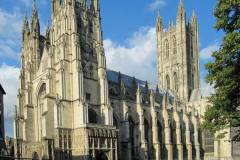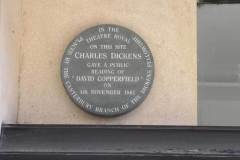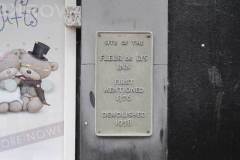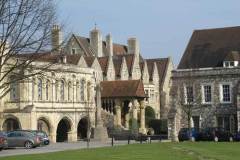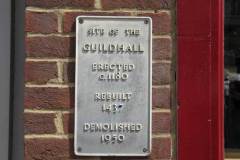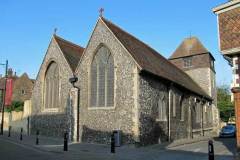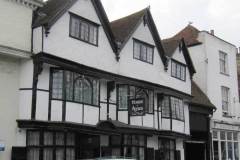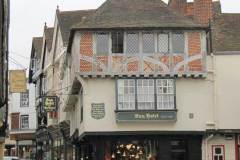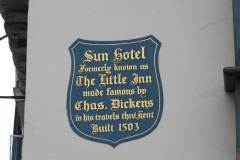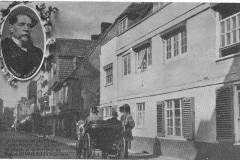(1812-1870) Victorian Novelist
Charles Dickens was born in Portsmouth but spent much of his working life in Kent, including periods in Rochester, Chatham and Broadstairs. He rose from humble origins to become the most successful novelist of his age.
Despite never living in Canterbury, he clearly knew it well. Apart from many direct references to Canterbury in his voluminous output, particularly in David Copperfield, he was quite able to act as a city guide when showing friends round. A good example arises in the diary of Annie Fields, wife of Dickens’ American agent, where on one visit she “explored the city under Dickens’ direction till it was nearly dark”. No fewer than 17 Canterbury sites have laid claim to some association with the much loved writer or with his literary characters. These are summarised below, the more convincing cases followed by some which seem wholly speculative:
- Dickens clearly was familiar with the cathedral (Image 1). Annie Fields (mentioned above) attended evensong with him during their visit. In David Copperfield, David attended services there regularly; and Mr Micawber wanted his son to become a chorister.
- Dickens gave a reading from David Copperfield at the new Theatre Royal (Image 2) in 1861.
- There is written evidence that Dickens made use of the Fountain Hotel in St Margaret’s Street (demolished by WW2 bombs in 1942) when he visited the city. The Fleur de Lys hotel in Canterbury High Street (demolished in the 1950s) is now marked by a small plaque by the Card Factory shop (Image 3). Claims that Dickens stayed here are not substantiated – it seems more plausible that he came to the city on day visits
- David Copperfield was educated in Canterbury, and much of his description of “Dr Strong’s Academy” suggests that it is modelled on King’s School (Image 4). Similarities between Dr Strong and the then headmaster, Dr John Birt are striking – they shared an equable temperament, both married late in life to women who were much younger, both loved music, and so on. Unfortunately, Dickens apparently wrote later to the school to deny the connection (see web site link below).
- The Guildhall (Image 5) gets a mention in David Copperfield when David is asked by Traddles the barrister to “go round to the Guildhall and bring a couple of officers” to deal with Uriah Heep.
- St Alphege church (Image 6) is mentioned in David Copperfield as the place where Dr Strong marries Annie Markleham.
- The House of Agnes in St Dunstan’s Street (Image 7) certainly meets the description of the home of Mr Wickfield the solicitor in David Copperfield “a very old house bulging out over the road; a house with long low lattice-windows bulging out still farther, and beams with carved heads on the ends bulging out too, so that I fancied the whole house was leaning forward…”, but so in reality do many others. The sole evidence seems to be strong “local tradition”.
- Perhaps the strongest Dickens link in local minds is with the Sun Inn (Image 8), which bears a plaque (Image 9 and 10) advertising the association. Doubters point to the fact that a link with another earlier Sun Hotel, currently the Cathedral Gate hotel standing beside the Christ Church gate, is just as plausible.
- The last of the specific references is a postcard that purports to show ‘A house in Burgate … the interior of which is described as that of Mr Wickfield’s residence’ (Image 10). This property – currently Fired Earth Interiors – was once the premises of solicitors Plummer & Fielding – (since absorbed into Furley Page solicitors). These surnames turn up in the Dickens novella ‘Cricket on the Hearth’ – it is tempting to think that Dickens saw the solicitors’ name plate when visiting the city, and used them in the novella.
- Other supposed links abound. David and his aunt come in to Canterbury on market day “insinuating the grey pony among carts, baskets, vegetables, and huckster’s goods”- commentators have read this to describe the Buttermarket but with no concrete evidence. The humble home of Uriah Heep has been claimed in North Lane and in Burgate but both candidates lacked real evidence and both have since been demolished; another demolished home on Lady Wooton’s Green was supposedly the model for Dr Strong’s home (he surely would have lived in the Precincts?); a nearby building (close to this but also now demolished) was claimed to be where David Copperfield was written; and others have seen the Queen Elizabeth Guest Chamber in the High Street as a model for the Wickfield’s home.
Sources: Canterbury Environment Centre (1998); for Annie Fields see Curry (1988); Wilson (1927); Dickens entry in Oxford Dictionary of National Biography
For Dickens’ letter denying links to Dr John Birt see this link
For reference to the solicitors Plummer & Fielding see Rambles in Dickens’ Land by Robert Allbut (Chapman & Hall, 1903) p.135 – the related postcard (Image 10) appears in The Charles Dickens Connection (Canterbury Environment Centre, 1998) p.5 and is also reproduced in Britain in Old Photographs – Canterbury by Derek Butler (Budding Books, 1989) p114.
DL

